Performance Management: Decision Making Factors Analysis Report
VerifiedAdded on 2020/06/06
|7
|1292
|35
Report
AI Summary
This report delves into the intricacies of performance management, emphasizing its crucial role in organizational success. It explores the systematic procedures of developing, supporting, directing, and controlling individual and team performance, highlighting its significance in shaping a company's market position. The report examines the factors influencing decision-making within performance management, including uncertainty and risk assessments. It provides an in-depth analysis of various approaches such as Maximin, Maximax, Minimax-regret, and Expected-value techniques, offering insights into how these methods aid managers in making informed decisions. The conclusion underscores the importance of performance management in analyzing individual and team performance and addressing the challenges posed by uncertainty and risk factors in business operations.
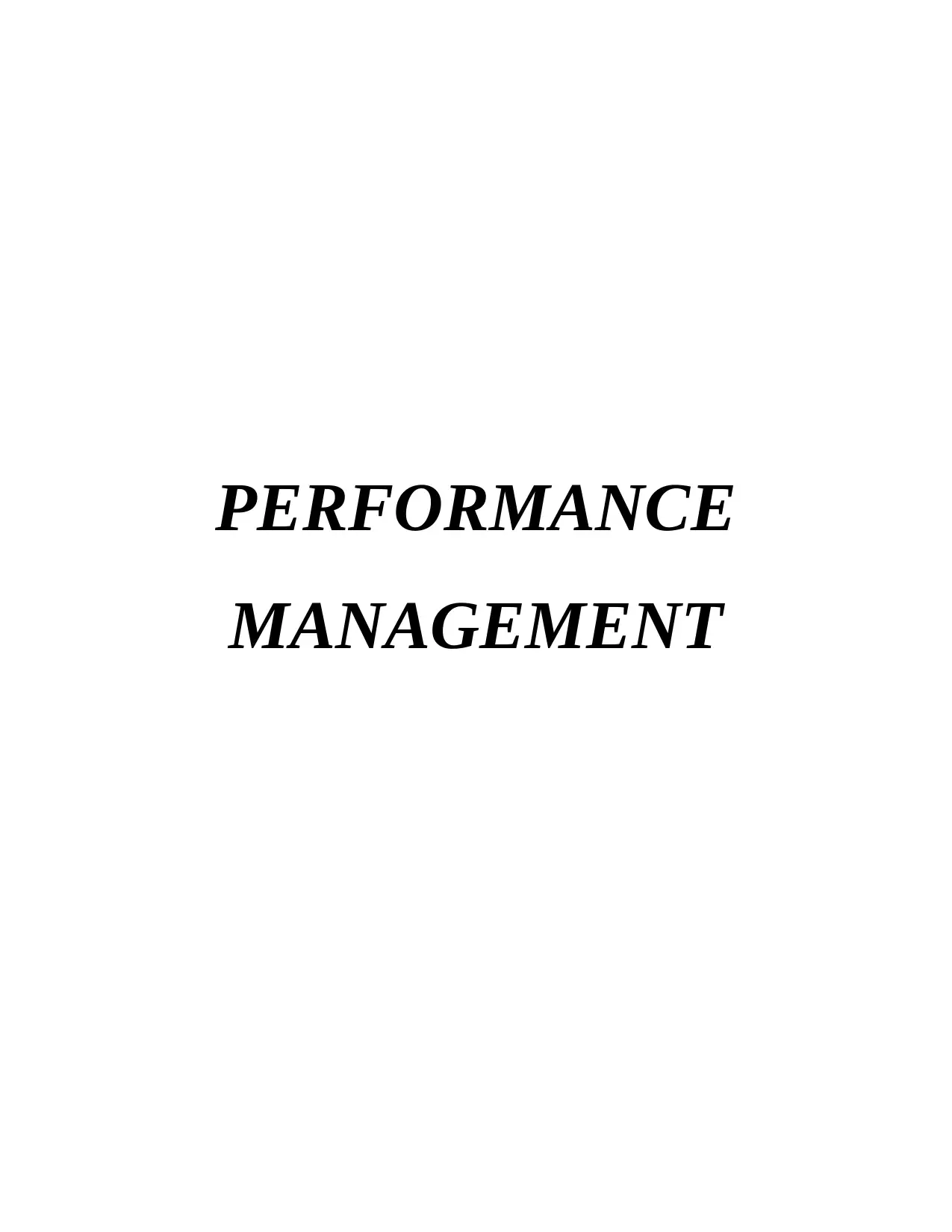
PERFORMANCE
MANAGEMENT
MANAGEMENT
Paraphrase This Document
Need a fresh take? Get an instant paraphrase of this document with our AI Paraphraser

Table of Contents
INTRODUCTION...........................................................................................................................1
TASK 1............................................................................................................................................1
a): Factors that affect in decision making...................................................................................1
CONCLUSION................................................................................................................................4
REFERENCES................................................................................................................................5
INTRODUCTION...........................................................................................................................1
TASK 1............................................................................................................................................1
a): Factors that affect in decision making...................................................................................1
CONCLUSION................................................................................................................................4
REFERENCES................................................................................................................................5
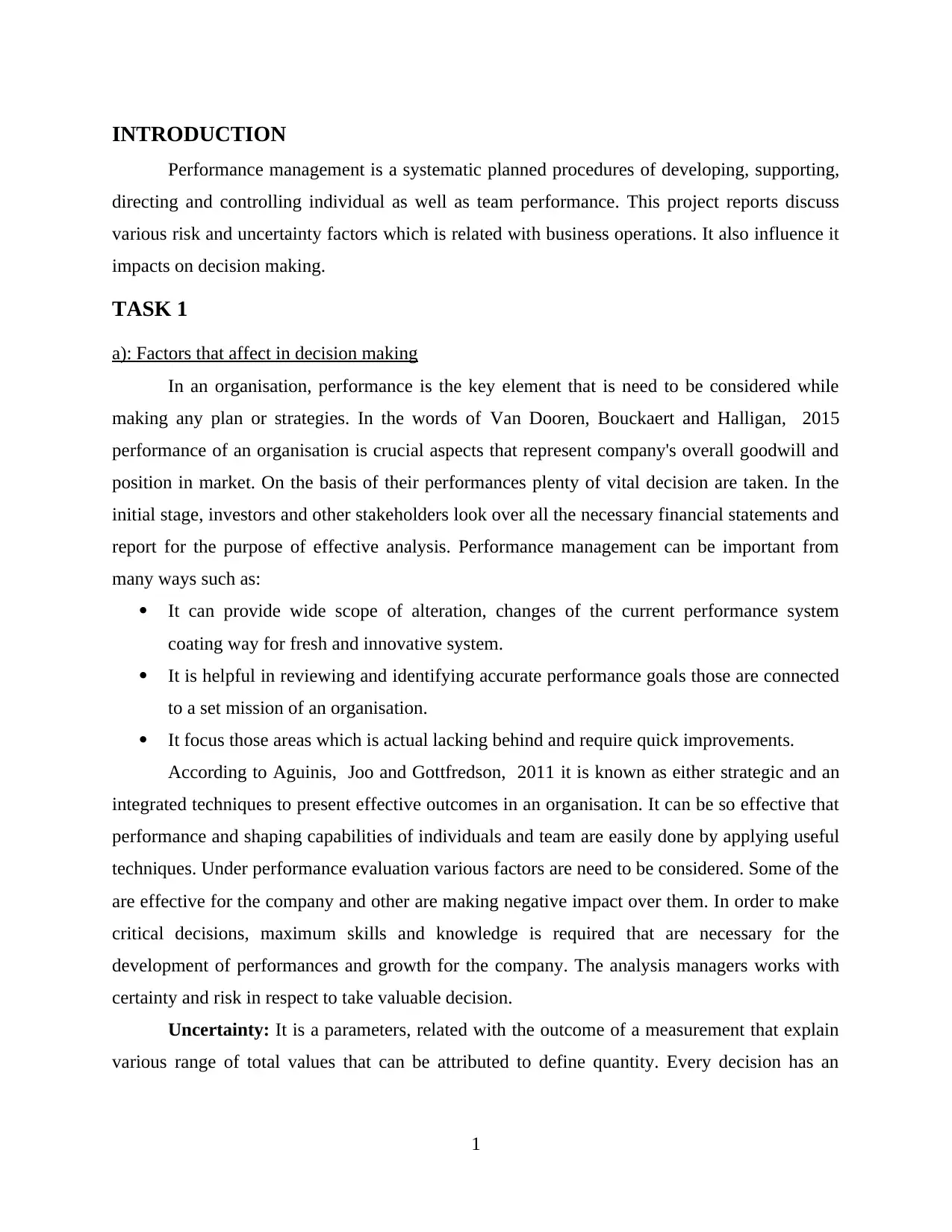
INTRODUCTION
Performance management is a systematic planned procedures of developing, supporting,
directing and controlling individual as well as team performance. This project reports discuss
various risk and uncertainty factors which is related with business operations. It also influence it
impacts on decision making.
TASK 1
a): Factors that affect in decision making
In an organisation, performance is the key element that is need to be considered while
making any plan or strategies. In the words of Van Dooren, Bouckaert and Halligan, 2015
performance of an organisation is crucial aspects that represent company's overall goodwill and
position in market. On the basis of their performances plenty of vital decision are taken. In the
initial stage, investors and other stakeholders look over all the necessary financial statements and
report for the purpose of effective analysis. Performance management can be important from
many ways such as:
It can provide wide scope of alteration, changes of the current performance system
coating way for fresh and innovative system.
It is helpful in reviewing and identifying accurate performance goals those are connected
to a set mission of an organisation.
It focus those areas which is actual lacking behind and require quick improvements.
According to Aguinis, Joo and Gottfredson, 2011 it is known as either strategic and an
integrated techniques to present effective outcomes in an organisation. It can be so effective that
performance and shaping capabilities of individuals and team are easily done by applying useful
techniques. Under performance evaluation various factors are need to be considered. Some of the
are effective for the company and other are making negative impact over them. In order to make
critical decisions, maximum skills and knowledge is required that are necessary for the
development of performances and growth for the company. The analysis managers works with
certainty and risk in respect to take valuable decision.
Uncertainty: It is a parameters, related with the outcome of a measurement that explain
various range of total values that can be attributed to define quantity. Every decision has an
1
Performance management is a systematic planned procedures of developing, supporting,
directing and controlling individual as well as team performance. This project reports discuss
various risk and uncertainty factors which is related with business operations. It also influence it
impacts on decision making.
TASK 1
a): Factors that affect in decision making
In an organisation, performance is the key element that is need to be considered while
making any plan or strategies. In the words of Van Dooren, Bouckaert and Halligan, 2015
performance of an organisation is crucial aspects that represent company's overall goodwill and
position in market. On the basis of their performances plenty of vital decision are taken. In the
initial stage, investors and other stakeholders look over all the necessary financial statements and
report for the purpose of effective analysis. Performance management can be important from
many ways such as:
It can provide wide scope of alteration, changes of the current performance system
coating way for fresh and innovative system.
It is helpful in reviewing and identifying accurate performance goals those are connected
to a set mission of an organisation.
It focus those areas which is actual lacking behind and require quick improvements.
According to Aguinis, Joo and Gottfredson, 2011 it is known as either strategic and an
integrated techniques to present effective outcomes in an organisation. It can be so effective that
performance and shaping capabilities of individuals and team are easily done by applying useful
techniques. Under performance evaluation various factors are need to be considered. Some of the
are effective for the company and other are making negative impact over them. In order to make
critical decisions, maximum skills and knowledge is required that are necessary for the
development of performances and growth for the company. The analysis managers works with
certainty and risk in respect to take valuable decision.
Uncertainty: It is a parameters, related with the outcome of a measurement that explain
various range of total values that can be attributed to define quantity. Every decision has an
1
⊘ This is a preview!⊘
Do you want full access?
Subscribe today to unlock all pages.

Trusted by 1+ million students worldwide
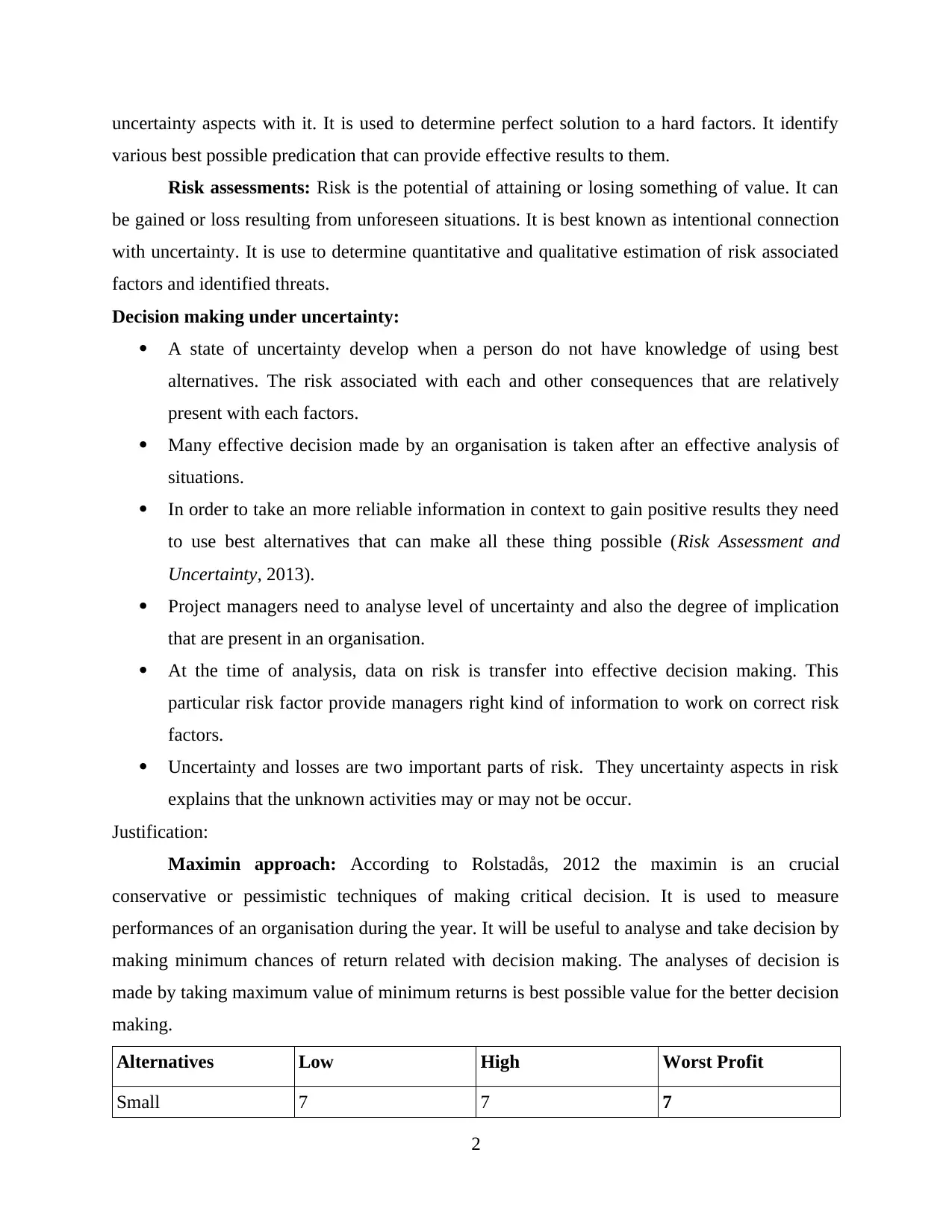
uncertainty aspects with it. It is used to determine perfect solution to a hard factors. It identify
various best possible predication that can provide effective results to them.
Risk assessments: Risk is the potential of attaining or losing something of value. It can
be gained or loss resulting from unforeseen situations. It is best known as intentional connection
with uncertainty. It is use to determine quantitative and qualitative estimation of risk associated
factors and identified threats.
Decision making under uncertainty:
A state of uncertainty develop when a person do not have knowledge of using best
alternatives. The risk associated with each and other consequences that are relatively
present with each factors.
Many effective decision made by an organisation is taken after an effective analysis of
situations.
In order to take an more reliable information in context to gain positive results they need
to use best alternatives that can make all these thing possible (Risk Assessment and
Uncertainty, 2013).
Project managers need to analyse level of uncertainty and also the degree of implication
that are present in an organisation.
At the time of analysis, data on risk is transfer into effective decision making. This
particular risk factor provide managers right kind of information to work on correct risk
factors.
Uncertainty and losses are two important parts of risk. They uncertainty aspects in risk
explains that the unknown activities may or may not be occur.
Justification:
Maximin approach: According to Rolstadås, 2012 the maximin is an crucial
conservative or pessimistic techniques of making critical decision. It is used to measure
performances of an organisation during the year. It will be useful to analyse and take decision by
making minimum chances of return related with decision making. The analyses of decision is
made by taking maximum value of minimum returns is best possible value for the better decision
making.
Alternatives Low High Worst Profit
Small 7 7 7
2
various best possible predication that can provide effective results to them.
Risk assessments: Risk is the potential of attaining or losing something of value. It can
be gained or loss resulting from unforeseen situations. It is best known as intentional connection
with uncertainty. It is use to determine quantitative and qualitative estimation of risk associated
factors and identified threats.
Decision making under uncertainty:
A state of uncertainty develop when a person do not have knowledge of using best
alternatives. The risk associated with each and other consequences that are relatively
present with each factors.
Many effective decision made by an organisation is taken after an effective analysis of
situations.
In order to take an more reliable information in context to gain positive results they need
to use best alternatives that can make all these thing possible (Risk Assessment and
Uncertainty, 2013).
Project managers need to analyse level of uncertainty and also the degree of implication
that are present in an organisation.
At the time of analysis, data on risk is transfer into effective decision making. This
particular risk factor provide managers right kind of information to work on correct risk
factors.
Uncertainty and losses are two important parts of risk. They uncertainty aspects in risk
explains that the unknown activities may or may not be occur.
Justification:
Maximin approach: According to Rolstadås, 2012 the maximin is an crucial
conservative or pessimistic techniques of making critical decision. It is used to measure
performances of an organisation during the year. It will be useful to analyse and take decision by
making minimum chances of return related with decision making. The analyses of decision is
made by taking maximum value of minimum returns is best possible value for the better decision
making.
Alternatives Low High Worst Profit
Small 7 7 7
2
Paraphrase This Document
Need a fresh take? Get an instant paraphrase of this document with our AI Paraphraser
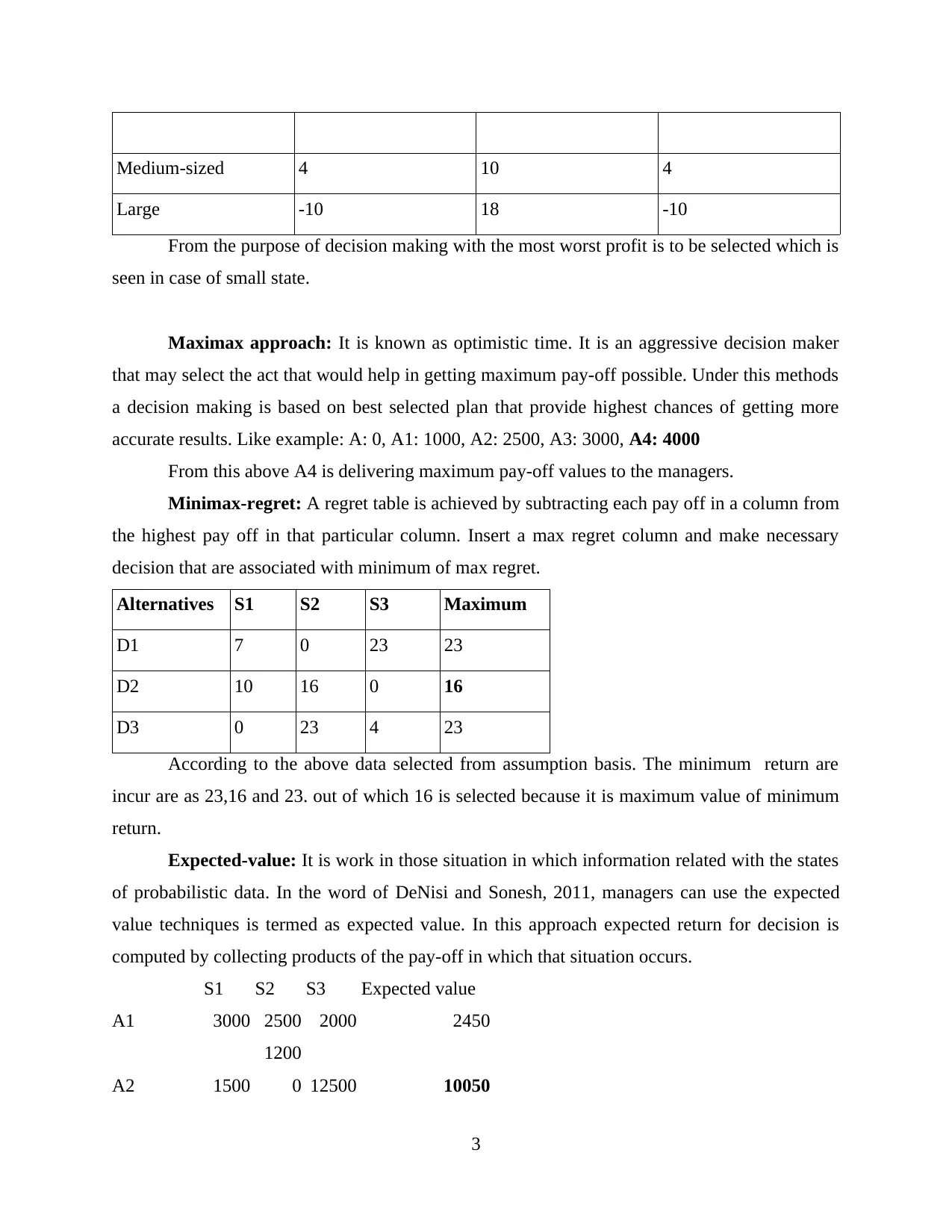
Medium-sized 4 10 4
Large -10 18 -10
From the purpose of decision making with the most worst profit is to be selected which is
seen in case of small state.
Maximax approach: It is known as optimistic time. It is an aggressive decision maker
that may select the act that would help in getting maximum pay-off possible. Under this methods
a decision making is based on best selected plan that provide highest chances of getting more
accurate results. Like example: A: 0, A1: 1000, A2: 2500, A3: 3000, A4: 4000
From this above A4 is delivering maximum pay-off values to the managers.
Minimax-regret: A regret table is achieved by subtracting each pay off in a column from
the highest pay off in that particular column. Insert a max regret column and make necessary
decision that are associated with minimum of max regret.
Alternatives S1 S2 S3 Maximum
D1 7 0 23 23
D2 10 16 0 16
D3 0 23 4 23
According to the above data selected from assumption basis. The minimum return are
incur are as 23,16 and 23. out of which 16 is selected because it is maximum value of minimum
return.
Expected-value: It is work in those situation in which information related with the states
of probabilistic data. In the word of DeNisi and Sonesh, 2011, managers can use the expected
value techniques is termed as expected value. In this approach expected return for decision is
computed by collecting products of the pay-off in which that situation occurs.
S1 S2 S3 Expected value
A1 3000 2500 2000 2450
A2 1500
1200
0 12500 10050
3
Large -10 18 -10
From the purpose of decision making with the most worst profit is to be selected which is
seen in case of small state.
Maximax approach: It is known as optimistic time. It is an aggressive decision maker
that may select the act that would help in getting maximum pay-off possible. Under this methods
a decision making is based on best selected plan that provide highest chances of getting more
accurate results. Like example: A: 0, A1: 1000, A2: 2500, A3: 3000, A4: 4000
From this above A4 is delivering maximum pay-off values to the managers.
Minimax-regret: A regret table is achieved by subtracting each pay off in a column from
the highest pay off in that particular column. Insert a max regret column and make necessary
decision that are associated with minimum of max regret.
Alternatives S1 S2 S3 Maximum
D1 7 0 23 23
D2 10 16 0 16
D3 0 23 4 23
According to the above data selected from assumption basis. The minimum return are
incur are as 23,16 and 23. out of which 16 is selected because it is maximum value of minimum
return.
Expected-value: It is work in those situation in which information related with the states
of probabilistic data. In the word of DeNisi and Sonesh, 2011, managers can use the expected
value techniques is termed as expected value. In this approach expected return for decision is
computed by collecting products of the pay-off in which that situation occurs.
S1 S2 S3 Expected value
A1 3000 2500 2000 2450
A2 1500
1200
0 12500 10050
3
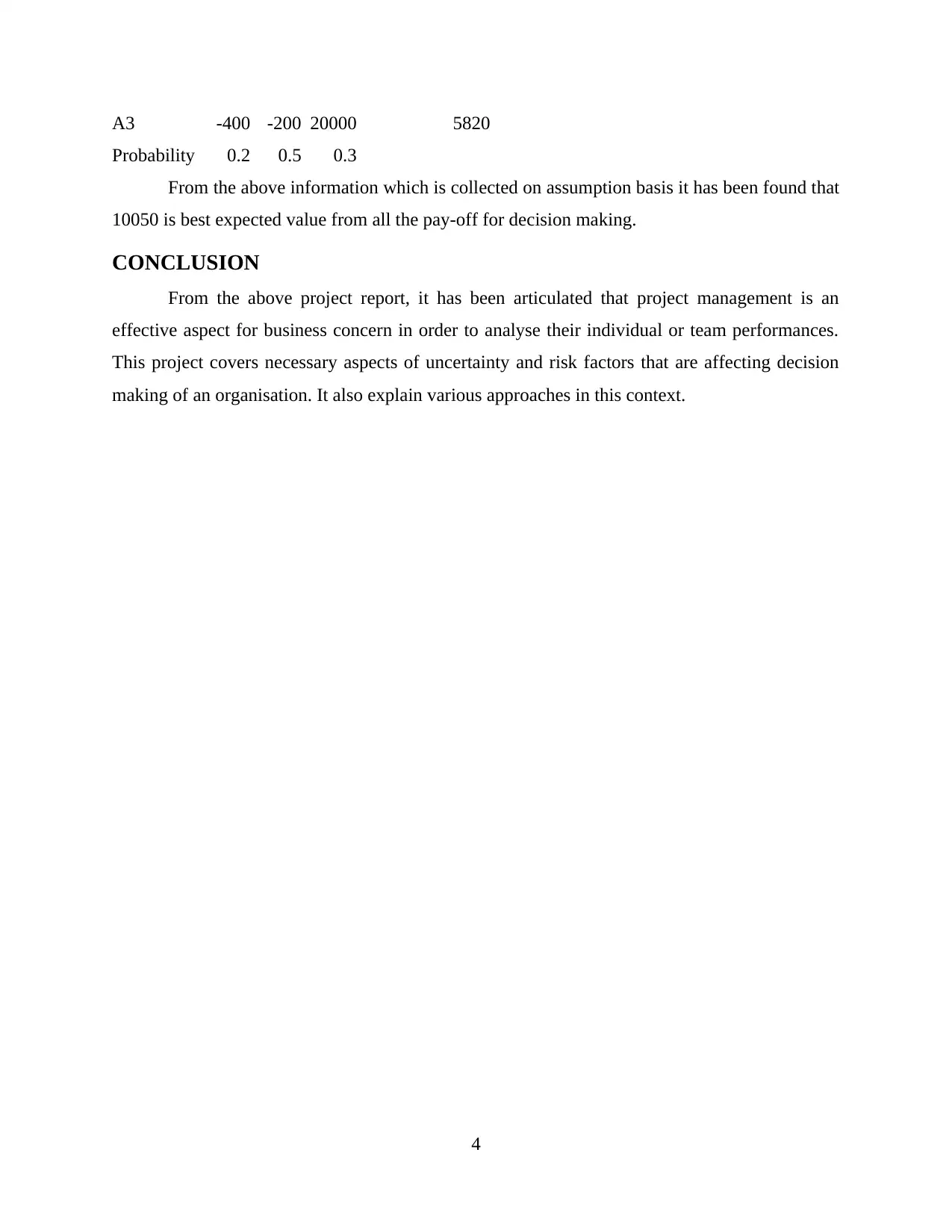
A3 -400 -200 20000 5820
Probability 0.2 0.5 0.3
From the above information which is collected on assumption basis it has been found that
10050 is best expected value from all the pay-off for decision making.
CONCLUSION
From the above project report, it has been articulated that project management is an
effective aspect for business concern in order to analyse their individual or team performances.
This project covers necessary aspects of uncertainty and risk factors that are affecting decision
making of an organisation. It also explain various approaches in this context.
4
Probability 0.2 0.5 0.3
From the above information which is collected on assumption basis it has been found that
10050 is best expected value from all the pay-off for decision making.
CONCLUSION
From the above project report, it has been articulated that project management is an
effective aspect for business concern in order to analyse their individual or team performances.
This project covers necessary aspects of uncertainty and risk factors that are affecting decision
making of an organisation. It also explain various approaches in this context.
4
⊘ This is a preview!⊘
Do you want full access?
Subscribe today to unlock all pages.

Trusted by 1+ million students worldwide
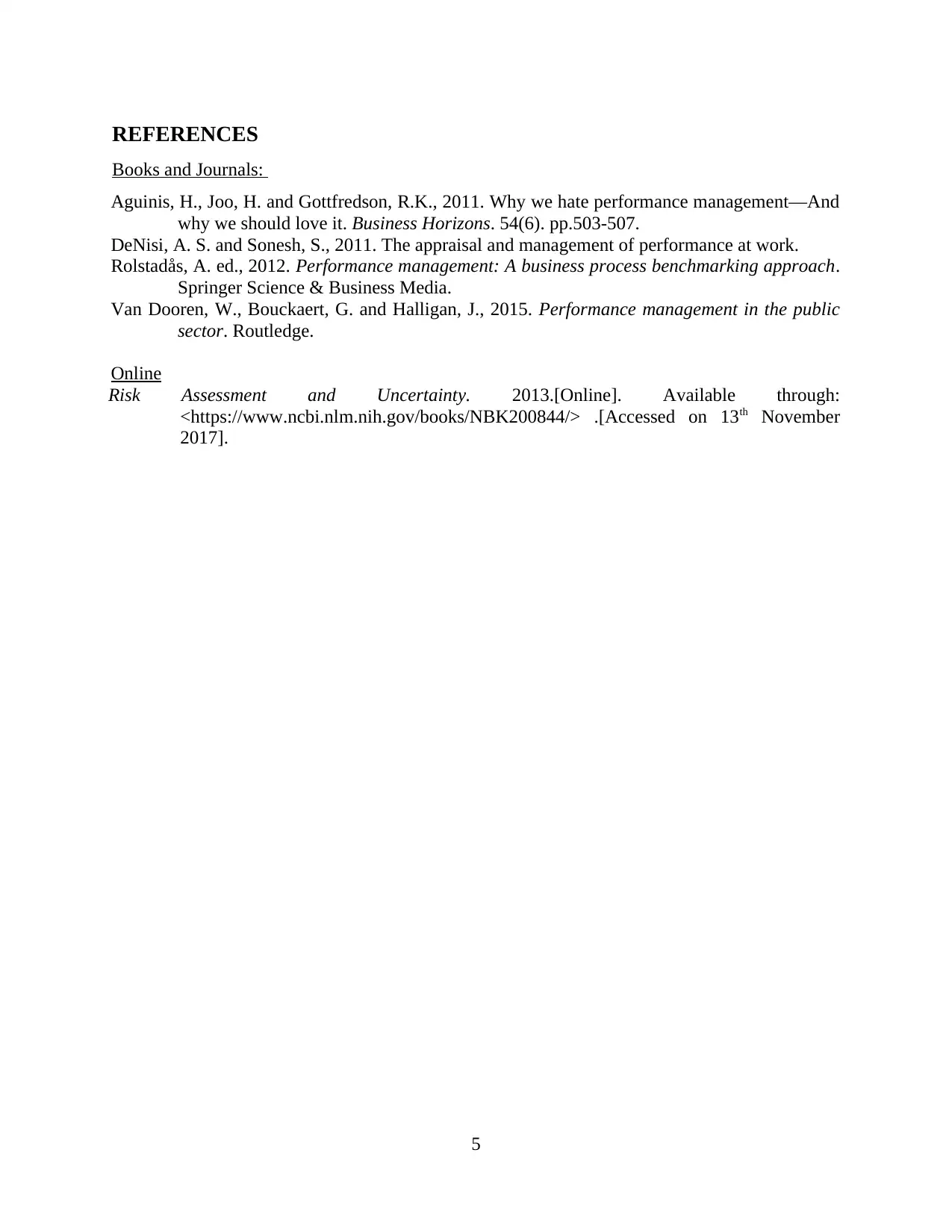
REFERENCES
Books and Journals:
Aguinis, H., Joo, H. and Gottfredson, R.K., 2011. Why we hate performance management—And
why we should love it. Business Horizons. 54(6). pp.503-507.
DeNisi, A. S. and Sonesh, S., 2011. The appraisal and management of performance at work.
Rolstadås, A. ed., 2012. Performance management: A business process benchmarking approach.
Springer Science & Business Media.
Van Dooren, W., Bouckaert, G. and Halligan, J., 2015. Performance management in the public
sector. Routledge.
Online
Risk Assessment and Uncertainty. 2013.[Online]. Available through:
<https://www.ncbi.nlm.nih.gov/books/NBK200844/> .[Accessed on 13th November
2017].
5
Books and Journals:
Aguinis, H., Joo, H. and Gottfredson, R.K., 2011. Why we hate performance management—And
why we should love it. Business Horizons. 54(6). pp.503-507.
DeNisi, A. S. and Sonesh, S., 2011. The appraisal and management of performance at work.
Rolstadås, A. ed., 2012. Performance management: A business process benchmarking approach.
Springer Science & Business Media.
Van Dooren, W., Bouckaert, G. and Halligan, J., 2015. Performance management in the public
sector. Routledge.
Online
Risk Assessment and Uncertainty. 2013.[Online]. Available through:
<https://www.ncbi.nlm.nih.gov/books/NBK200844/> .[Accessed on 13th November
2017].
5
1 out of 7
Related Documents
Your All-in-One AI-Powered Toolkit for Academic Success.
+13062052269
info@desklib.com
Available 24*7 on WhatsApp / Email
![[object Object]](/_next/static/media/star-bottom.7253800d.svg)
Unlock your academic potential
Copyright © 2020–2025 A2Z Services. All Rights Reserved. Developed and managed by ZUCOL.





